Karen Commins's Blog, page 3
December 8, 2021
Right of Publicity
Happy belated birthday Walt Disney!
I narrated, produced, and published the public domain book The Story of Walt Disney by Diane Disney Miller and Pete Martin. I was thrilled that it released on 5 December in celebration of the 120th anniversary of Disney’s birth.
While I’m excited to announce this audiobook, I’m writing this post to talk about its cover art, and more specifically, information about image usage that may help you if you publish your audiobooks.
I’ve previously written about Copyrighted Images in a Public Domain Book.
That article discussed the images inside the book. Of course, the copyright laws also apply to the cover art, so I encourage you to read it.
Today, I want to talk about the laws concerning right of publicity. (Insert my usual disclaimer about not being a lawyer though I have voiced many in audiobooks.)
Original ArtworkSince I published the Disney audiobook, it was up to me to acquire appropriate cover art for it.
If you license the audio rights to a book still protected by copyright, you may be able to negotiate the usage of the cover art as part of the deal, depending on who owns the image. Even though a book may have entered the public domain, you can’t assume that you can use the original cover on your audiobook.
When the hardback book was published in 1957, it had this illustration on the book jacket. The design was carried over to the later paperback edition.
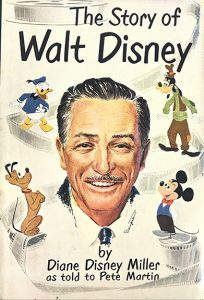
I learned in my research that Al Dempster was a Disney artist who worked on backgrounds in numerous movies and the illustrations for Golden Books. Walt thought Al was a wonderful artist and even owned and displayed some of Al’s paintings in his home.
I felt sure that Walt owned the copyright to this image in part because I saw a Disney work-for-hire contract.
It really wouldn’t matter, though, because all of those drawings of his copyrighted characters could land me in trouble with his company, which I believe is one of the most litigious companies on the planet.
Search For New Image
Although I couldn’t use the original art, I wanted to keep the illustrated look of the cover. I found great drawings of Walt in these First Day Covers (FDCs) sold on eBay.
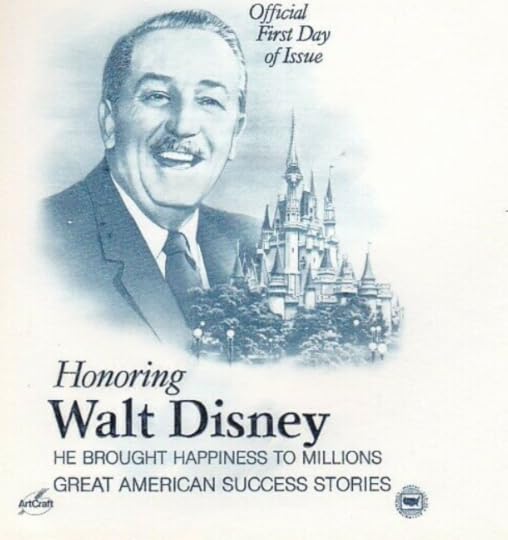
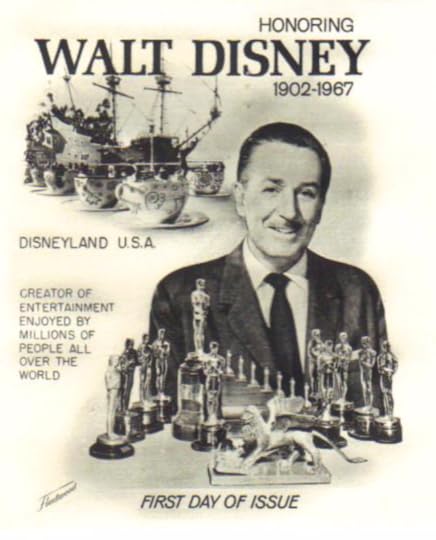
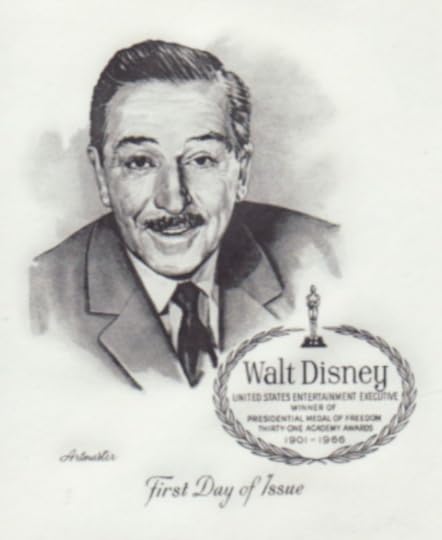
I spent time researching the companies that produced these FDCs but kept running into dead ends. Many companies have merged or dissolved. I tracked one to the last owner but never got a response to my voice message or email.
“Fine”, I thought. “I’ll just find a great public domain photograph of Walt Disney and use it on my audiobook cover.”
Using my article Tour of Sites With Public Domain Art as my guide, I looked on various sites. I loved this picture of Walt in 1946 that I discovered on Wikimedia Commons.
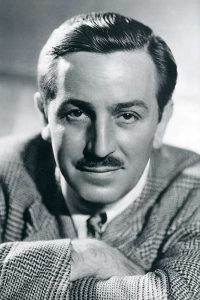
The page notes that this image was a publicity shot from the Boy Scouts of America and not copyrighted.
Before I made a final decision, I wanted to check the motherlode of Disney pictures at Getty Images.
Several pictures including this one immediately stood out, and for more reasons than the aesthetic appeal.
Embed from Getty Imageswindow.gie=window.gie||function(c){(gie.q=gie.q||[]).push(c)};gie(function(){gie.widgets.load({id:'ladZliOfRfZj9EFRndcqew',sig:'NuXtEeoOhmEbnrFWHwWfZcbu0i0JUxafSTgrBcYwp3k=',w:'300px',h:'450px',items:'102678327',caption: true ,tld:'com',is360: false })});First, the cost jumped off the page . Beyond that, let me draw your attention to the DETAILS on the right side.
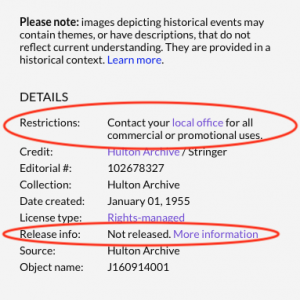
You see that commercial use is restricted. In addition, it states “Not released.” These 2 words caused me to do more research and are the foundation for this post.
The Getty site explains that you need a release to:
Right of Publicityensure that the people and owners of property in the image or video gave permission for the image or video to be used for commercial purposes.
The right of publicity is the underlying reason why a release is needed. The Cornell Law site defines the right of publicity this way:
The right of publicity prevents the unauthorized commercial use of an individual’s name, likeness, or other recognizable aspects of one’s persona. It gives an individual the exclusive right to license the use of their identity for commercial promotion.
In the United States, the right of publicity is largely protected by state common or statutory law. Only about half the states have distinctly recognized a right of publicity.
If the right of publicity seems familiar, you may have heard about the recent case where voice actor Beverly Standing sued TikTok in federal court for using her voice without her permission. (The case was settled out of court.) The first line in the legal complaint asserted
This is a civil action for injunctive relief and damages for violation of Plaintiff’s right of publicity…
With an extraordinary number of celebrities making their home in California, I felt sure that state would be one that recognizes the right of publicity.
“But didn’t Walt Disney die in 1966?” I can hear you ask. “Wouldn’t his right of publicity have ended at that time?”
Not only does California have right of publicity laws, but the state created a separate law to protect the posthumous right of publicity which the Digital Media Law Project summarized
lasts for 70 years after death, and is considered a freely transferable, licensable, descendible property right.
Therefore, Walt Disney’s image wouldn’t be free to use in commercial ventures until 2037! In the meantime, his heirs could sue anyone who slapped his picture on their product.
It’s a good thing I couldn’t find the owners of the First Day Covers. Even with their permission to use their image, they could never give me Walt’s release.
My Artwork
Understandably, I chose to avoid eliminate Walt’s picture from the cover art for my audiobook!
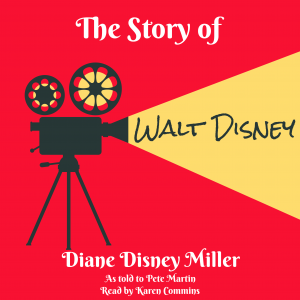
I found a great stock image and changed its colors to match those of Mickey Mouse.
You’ll notice that I also didn’t use Walt’s unique and very identifiable signature. Instead, I found a font that gives a feel of his handwriting.
It may have been Walt Disney’s birthday, but learning about the right of publicity was the present for me.
The post Right of Publicity appeared first on Karen Commins.
October 26, 2021
An Open Letter to Bee Audio
 Today Bee Audio’s new CEO Roy Forbes sent a disturbing email to all members on their production roster. He gleefully wrote about working with 2 different international companies “who share our vision and enthusiasm” to help develop AI Text-to-Speech (TTS) for audiobooks.
Today Bee Audio’s new CEO Roy Forbes sent a disturbing email to all members on their production roster. He gleefully wrote about working with 2 different international companies “who share our vision and enthusiasm” to help develop AI Text-to-Speech (TTS) for audiobooks.
I say he wrote “gleefully” because, as a professional audiobook narrator, I am skilled at analyzing an author’s printed words and interpreting the subtext, the underlying meaning.
One doesn’t have to be a professional narrator to also understand that such an email is completely tone-deaf and insulting to the workforce. We do not hold any “vision and enthusiasm” for technology meant to replace us!
Artificial intelligence can’t detect the subtext in a sentence, much less over the trajectory of an entire book. I can’t believe it ever would be that good.
One’s voice conveys the essence of being human. Nothing expresses our thoughts, feelings, and emotions better than the human voice. Words on a page can fall flat and be interpreted in different ways, where a speaker makes their views known in multiple ways like volume, pitch, tone, and pauses.
If someone only wanted to have a story read to them, they could use the text-to-speech capabilities on their computer or e-reader. Sure, the inflections and pronunciations are often wrong, and the entire reading lacks any kind overall understanding of the material needed to guide the listener.
Of course, visually impaired people benefit from TTS and understand its fallacies. Paying consumers require much more,
People buy audiobooks because they want to be entertained, informed, and inspired. An audiobook is a performance art based on the narrator’s interpretation of the author’s words. We do far more than simply read the words on the page!
Before I ever walk in to the booth to record an audiobook, I’ve carefully prepared for the moment:
I read the entire book.In a fiction book, I note all of the characters’ quirks and descriptions so that I can develop a convincing voice for each character and present them as real people in real circumstances, not some cartoon.In non-fiction books, I research the author and the content of the book so that I understand the message to be conveyed.I’ve done copious research on correct pronunciations. Anyone who has ever heard a GPS mispronounce the name of their town will be annoyed to have a computer voice mispronounce things in an audiobook. Mispronunciations take the listener out of the story.Once I’m recording the book, I’m careful to distinguish voices among the many characters, especially when they converse in the same scene. The listener always needs to know who is speaking. Whether fiction or non-fiction, I must make organic acting decisions that help realize the author’s intent.
My experiences and knowledge shape every word that I utter and breathe LIFE into printed words.
I know that the narrator is the greatest cost in audiobook production, and companies perpetually look for ways to cut expenses. However, taking steps to remove the human voice and replace it with a synthesized one destroys the art form.
Technology is ideal for robots to replace humans in soul-sucking jobs like installing computer chips on a circuit board. It will never replace a human’s ability to convey emotion.
Since Bee Audio is actively participating in the development of TTS to replace narrators in audiobooks, I cannot in good conscience stay on their roster. I also encourage other narrators to avoid this company unless its “vision and enthusiasm” changes in favor of pro narrators.
Perhaps Bee’s TTS applications will be voicing their audiobooks even sooner than they realized.
The post An Open Letter to Bee Audio appeared first on Karen Commins.
October 20, 2021
Narrator’s Cup of Joe — 2nd Cup
Recently, I had the great pleasure of being a guest on Daniela Acitelli‘s fabulous Narrator’s Cup of Joe show. Daniela is an effervescent and skilled interviewer who asks meaningful questions and makes you eager to tell her all of your secrets! I know I did!
Naturally, I want to share some links to expand our discussion and give you some helpful resources. I’ll add the time codes below with the links.
03:42 The first time I identified my day job employer on my blog was in the article titled My life as a secret agent.
13:37 Here’s Neil Gaiman’s exact quote from his 2012 commencement address at the University of the Arts in Philadelphia:
I decided that I would do my best in future not to write books just for the money. If you didn’t get the money, then you didn’t have anything. If I did work I was proud of, and I didn’t get the money, at least I’d have the work.
15:24 (also 48:55 and 58:09) I’ve written about Evernote several times on my blog:
Putting the “I” in Organized Why Use Evernote for Audiobook Pronunciation Research Plan Your Work and Work Your Plan17:38 This site has a good overview about the Myers-Briggs Personality test.
23:07 I had never told people about the reason I played oboe until Daniela asked what drives me. (Didn’t I say that she got me to tell all?!) I mentioned being able to stand out in high school band by playing oboe in this article about listening to the still small voice.
After the call concluded, I wrote in the Narrators Cup of Joe Facebook group:
I realized I said “I don’t audition well.” I am going to speak affirmations to change that negative energy so that my grade school past doesn’t become my narrator future!
36:36 The article I wrote when I finally left my day job was 5 Quick Tips for Following Your Dreams.
37:10 Bonnie Gillespie introduced me to the term “thrival job” in her column about them. I wish I’d known the phrase when I wrote Plugs for a day job and the environment.
38:31 The book I discussed was Barbara Sher’s I Could Do Anything If I Only Knew What it Was: How to Discover What You Really Want and How to Get It. I’ve written several articles that reference Sher’s books:
How to lose friends and irritate people Creating your roadmap to success Every passion does not lead to a career choice40:13 Drew and I dished about how we met in this 2:28 video we created to promote an audiobook we narrated together.
43:07 Volunteering as a reader for your state’s reading service for visually impaired people helps you grow skills and provides a needed service to the community.
1:01:36 I use a lot of shortcuts and automation to get more things done, as I described in this article.
1:05:56 I placed these reminders on my office desk to help prevent the distractions of social media from negatively taking root in my spirit. Left to right, they say:
Find joy in every journey. Laugh.
I have arrived. (You can make Bart Simpson write your own message on his chalkboard at this site.Take a screen shot and print the picture for your own reminder.)
Run your own race.
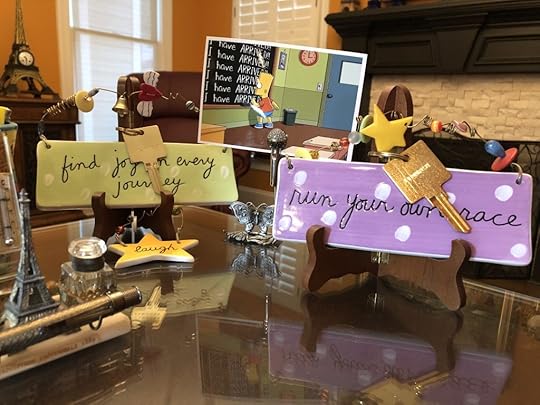
1:08:08 If you also want to read Nancy Cartwright’s columns in Animation World Network, let me point out:
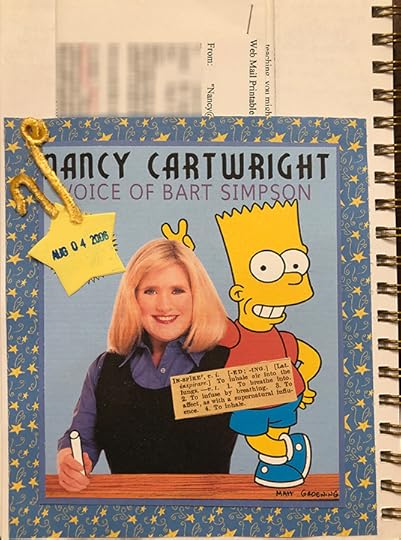 I printed Nancy’s 4 August 2008 email to me and saved it in my journal in a pocket that I created as a collage.
I printed Nancy’s 4 August 2008 email to me and saved it in my journal in a pocket that I created as a collage.
1:11:02 In this article, I quoted Eckhart Tolle’s profound statements about giving out what you think you lack as a reason to create your own projects.
1:13:18 If you’re interested in the power of affirmation spoken to that face you see in the mirror, I highly recommend Louise Hay’s book Mirror Work: 21 Days to Heal Your Life.
1:17:59 My travels have inspired a number of my articles, including:
10 Business Tips From My Day at the Great Pyramids Shining the light on pitches to prospects Cruising for a competitive advantage 5 marketing lessons from Ralph the artist1:18:50 OF COURSE I’ve written about and posted pictures of Barry Manilow on my blog, mostly about him as a marketing example we can all follow!
Hollywood Star Search 3 Cs of Branding Illustrated by Barry Manilow 3 Cs? Make that *4Cs* of Branding Illustrated by Barry Manilow (this one includes an audio clip where I actually got to SPEAK with THE MAN!)I really enjoyed my far-reaching conversation with Daniela and hope that you did, too!
The post Narrator’s Cup of Joe — 2nd Cup appeared first on Karen Commins.
October 15, 2021
Creating Original Material
I recently was approached by a person who wanted to translate some of NarratorsRoadmap.com for their site. I decided to share my response here with the hope it inspires others to create your own original material. Also, long-time readers know that I re-purpose my writing as often as possible to extend its life and broaden the audience for it.
**********************
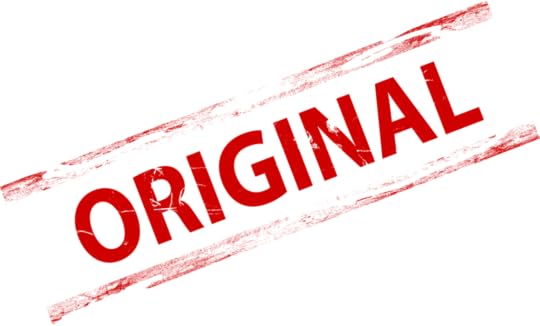
I didn’t just gather info for my site. I wrote most of it, which took considerable time and effort, not to mention the years spent in gaining the knowledge to start with.
Everything on my site is my copyrighted material with a few exceptions:
A good number of the links and most of the embedded videos point to copyrighted info on other sites. Many of the articles and videos I link to are mine!Some narrators and producers have generously given me permission to republish their copyrighted words in my Knowledge Base articles.Copyright owners have the rights to control how their work goes forth in the world, including:
reproductiondistributionperformancedisplayderivative products like translationsMy aim is to create more content, not translate what I’ve already done.
If I decide in the future to translate the site, I would hire the translators and own the translated text. Such translations would only appear on my site.
I therefore am declining any request to translate any part of my site.
Note: I hold the same policy about my blog articles on this site but have given permission for my articles to be re-published as written and with link and attribution.
However, I would encourage you to think about how you could create and share your own original material.
We all have unique experiences, views, and ways of expressing ourselves, even when we’re talking about the same topic. You could write a blog, produce a podcast, create videos, design inspirational/informative graphics, etc. You could create a variety of things as it suits you and your purpose.
When I worked my day job in IT, users and my peers considered me an expert. I helped other system admins solve technical problems and taught the users how their software and hardware worked.
I began working in VO in 1999 and started my first advice page on my site in 2002. I have been writing my blog since 2006. As I shared posts, people in the industry got to know and trust me through my blog. Soon, people began referring others to my blog.
NarratorsRoadmap.com is an extension not only of my blog and advice I’d given online and in emails for years, but of my personality and whole approach to being of service.
My point is: If you start creating and sharing your own content, you never know where it will lead!
I found Austin Kleon’s book Show Your Work! 10 Ways to Share Your Creativity and Get Discovered to be VERY helpful and inspirational in connecting the dots about growing an audience. Basically, he contends — and I agree — that If you can think of ways to document things about your work processes, an interested audience will make its way to you.
Let me know if you create something along these lines. I may want to link to you!
The post Creating Original Material appeared first on Karen Commins.
August 17, 2021
Tour of Sites With Public Domain Art
Material in the public domain belongs to ALL of us. You can use public domain material for any purpose you want without licensing it or paying royalties to anyone.
Public domain books are a boon to creative, entrepreneurial narrators! I made a video course exclusively for members of my NarratorsRoadmap.com site called Create Your Own Path. The first video discusses how to research the copyright information to determine whether a book is in the public domain. (I would be remiss if I didn’t also point out that the course has its own set of resources, including collections of public domain books I’ve created for members to peruse for possible projects!)
When planning your cover art for public domain books, consider these quotes pulled from this Publishers Weekly article about publishing new editions of public domain texts:
“It’s been 95 years since they were published in the United States — so we’re thinking about how we can present them as fresh and relevant.”
“The design process for reimagining classic covers also requires a special sort of attention…You just need a cover that’s going to jump out from all the other covers.”
“I always feel it’s important to create covers for classic authors that they would appreciate. I think it’s really important to be respectful of the text.”
Many people who create audiobooks from public domain texts also look to use public domain artwork for their audiobook covers. I’ve done that with a number of books, including:



I found the image for JAILED FOR FREEDOM on the Library of Congress site. The sun on THE DYNAMIC LAWS OF PROSPERITY came from NASA.
You may even need to layer images to achieve the look you want. In the case of SO BIG, my cover designer found a perfect antique, public domain painting of the woman standing in the cabbage field. Meanwhile, I found a modern photograph of a farm boy squatting in a field on a commercial site of stock images. I bought the picture for around $15 and then used Photoshop to place him in the image of the painting with Photoshop. I used a number of filters and effects to give him the same look as the original painting.
Since I’ve seen a number of posts from narrators looking for sources of public domain illustrations, I thought I’d curate a handy list for all of us! Note that I’m not including the plethora of sites with modern stock images or that may charge fees for usage.
 I found these illustrated letters in the British Library collection. I colorized and joined them together.
I found these illustrated letters in the British Library collection. I colorized and joined them together.Commercial Sites
While a piece of art might be in the public domain, a contemporary photographer may hold a copyright on their picture of the art. Be sure to do due diligence to ensure that an image you want to use is in the public domain or may be used without restriction.
Flickr.com
You can specify on your search that you’re looking for “No known copyright restrictions”, “U.S. Government works”, or other license choices.
Google
The advanced search allows you to choose usage rights among all, Creative Commons, and commercial.
HeritageLibrary
You’ll find multiple vintage illustrations of the same theme bundled on the same image.
RawPixel
This site has a number of categories of images, including artists and animals.
Wikimedia Commons
Wikimedia offers over 75 million pictures that you can download and use. Its topic searches are useful for zeroing in on useful images.
Federal Government
Work created by federal government employees in their official duties and/or issued by government offices generally is not copyrighted and is in the public domain. This page offers a fuller explanation about copyright exceptions on government works.
A number of government sites contain searchable directories of images, including:
US Department of Agriculture (USDA) Pomological Watercolor Collection
This site describes and links to image libraries for over a dozen agencies.
Libraries
Baldwin Library of Historical Children’s Literature
The Smithsonian called this site a treasure trove of digitized, Victorian-era children’s books.
Biodiversity Heritage Library
If you’re looking for flora and fauna, you’ll want to search the images here.
British Library
The British Library posts on Flickr, with pictures categorized into albums. Of special interest are the 2 collections:
Library of Congress
This page shows a sample of the collections owned by the Library of Congress. However, they have so much more content that’s not linked here. I’ve found it helpful to do a Google site search on the main LoC.gov for the type of image I want, for example:
site:loc.gov 19th amendment suffragists then click Images when the search results appear
Metropolitan Museum of Art
Over 400,000 high-res images are available for open access download in this searchable database.
New York Public Library
You can do a general search or get really specific with a topic and/or genre search.
Museums
Cleveland Museum of Art
The museum offers “Open Access with Creative Commons: images, data and software CMA believes to be in the public domain, or that which CMA waives any copyright it might have .”
Digital Comic Book Museum
The site states: “All files here have been researched by our staff and users to make sure they are copyright free and in the public domain.” An Excel list of comics is linked in the forum FAQs.
J. Paul Getty Museum
The Getty has made images to which it owns the copyright along with public domain images available for download and free usage.
Metropolitan Museum of Art
Over 400,000 of the Met’s public domain images are available through its Open Access policy. This page has links to 20 thematic sets of images.
Museo.app
Presently, this site will search the following holdings:
Smithsonian Open Access
You can choose from more than 3 million images “from across the Smithsonian’s 19 museums, nine research centers, libraries, archives, and the National Zoo.”
Specialized Repositories
Old Book Illustrations
While searching for an illustration for a recent blog article, I found this site that specializes in Victorian and French Romantic illustrations.
Public Domain Review
Highlighting wonderful works in the public domain is the mission of this site. You can browse images by epoch, style, or theme. You may want to subscribe to their newsletter while you’re there.
Do you have a favorite site for public domain images? Please share it in the comments!
The post Tour of Sites With Public Domain Art appeared first on Karen Commins.
August 11, 2021
Copyrighted Images in a Public Domain Book
Narrator Pamela Almand recently wrote to me about images in a public domain book from a deceased author that she plans to narrate and produce as an audiobook. She kindly gave me permission to re-publish her question here so that more people can benefit from this discussion.
I have a question from you since you’ve done a bunch of these and are the acclaimed guru! I love the photographs included in the book and wonder if you’ve ever searched rights for illustrations or if, by virtue of them being in a PD title, they are considered PD also. I would love to add a downloadable pdf of the photos but don’t really know if that is allowed. If you can point me toward a resource I’d really appreciate it!
As you might imagine, this seemingly easy question has a complicated answer.
I’ll break it down in 3 parts.
The Law
Books and pictures published in or before 1925 are in the public domain. Each 1 January, a new year’s worth of books enter the public domain.
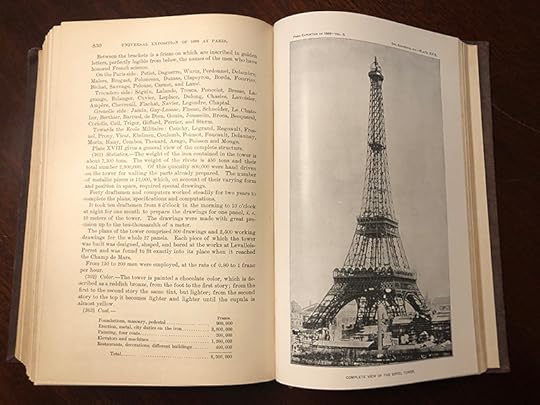 This book and all its pictures from the 1889 Paris Exposition was published in 1891 and has always been public domain. It was created under the direction of the US Secretary of State by the authority of the US Congress and carried no copyright notice.
This book and all its pictures from the 1889 Paris Exposition was published in 1891 and has always been public domain. It was created under the direction of the US Secretary of State by the authority of the US Congress and carried no copyright notice.In Pam’s case, the book was published in 1928. Using the links on this page, she determined the copyright wasn’t renewed, so the book is in the public domain.
However, the copyright owner(s) of many of the photographs in the book were different from the author, who was the copyright owner of the text. We don’t know the original publication dates of the images. As a result, it’s possible some of the pictures in the book remain under copyright.
The picture caption/attribution would indicate the copyright owner with language like “used by permission” or even a copyright symbol. If it doesn’t include such verbiage next to the picture or in a list elsewhere in the book, like on the copyright page or in the Acknowledgements, to indicate different ownership of the picture, the image would be the author’s and therefore could be included in her text copyright.
For instance, a page of plane maneuver pictures in Pam’s book states “Courtesy Standard Oil Company of Indiana” at the bottom.
Copyright owners maintain the separate rights to control copies and derivative products. You’d need the copyright owner’s permission to redistribute their image in your PDF. Technically, they could have given permission for the picture to appear in the printed book but could refuse your request to redistribute a copy in a PDF to accompany the audiobook.
In the booklet Managing Intellectual Property in the Book Publishing Industry published by the World Intellectual Property Organization (WIPO), we find the crux of the problem:
Rights owners of photographs will normally give a non-exclusive license for reproduction of the picture. This means it can be used once for the purpose and in the position requested, and may not even cover reprints (in other words, permission may need to be obtained every time the book is reprinted). So, if a publisher approaches a third party for permission to reproduce a photograph, he should expect the right granted to be quite limited. If later he wants to include that same photograph in another title or in a new edition (like a paperback), or he decides to change its size and put it on the cover, he will need to seek a fresh permission.
From a practical standpoint, the copyright owner may have passed away or, in the case of a company, no longer exist, though that point doesn’t give us permission to stop looking for them.
The images in question are illustrations and photographs that depict historical aircraft and various people associated with flying.
Going back to the plane maneuver pictures mentioned above, a quick Google search shows me that Standard Oil Company of Indiana merged with American Oil in 1925. They changed to the Amoco name in 1985, and in the 90s, Amoco merged with BP. Even if one could find the correct person in BP’s labyrinth to contact for permission, I think they probably would not answer.
The WIPO document addresses the scenarios of copyright owners who can’t be found and those who can be found but don’t respond:
Works should never be used without permission (right owner authorization, legal permission) in one form or another. In some cases when the excerpt is very small or very old (in other words, it is not sure whether or not it is still in copyright), or if it was not possible to track down the rights owner, publishers proceed with publication. In these unfortunate cases if several failed attempts have been made to trace the rights owner, evidence thereof is often collected (copies of letters, envelopes returned with messages such as ‘gone away’ or ‘not known’, a brief log of e-mails or phone calls that did not reach their destination, with a view to improving the legal standing of the publisher. These cases are different from those where the identity and location of the author are known and established, but he just chooses not to respond to the repeated requests. A court would regard this second example as tantamount to a refusal.
What About Fair Use?
While I am not a lawyer, it’s tempting to make an argument for including all of the pictures in the book in the PDF to accompany the audiobook. In the extremely unlikely event a copyright owner challenged your usage of a picture, you could either remove the picture from the PDF or cite the fair usage standard of copyright.
Fair Use rests on 4 subjective tests, which are, as quoted from the Stanford article linked above:
the purpose and character of your usethe nature of the copyrighted workthe amount and substantiality of the portion takenthe effect of the use upon the potential market or future value of the copyrighted workThe Stanford article also states:
Because the dissemination of facts or information benefits the public, you have more leeway to copy from factual works.
The WIPO document linked in the previous section advises us:
It must be borne in mind too, that there is no fair dealing precedent for illustration or web content – the ruling generally applies only to text. One of the reasons for this is that by reproducing a photograph or a picture, a whole work, not a part of it, is being reproduced.
How to Proceed
In this particular case, I’d create a supplemental PDF using all of the author’s pictures from the book, assuming the scanned images are suitable to reprint. I’d substitute images that are known to be public domain for any pictures potentially still under copyright.
As an example, an image of the Pan Am Clipper Ship is marked “Courtesy of Pan Am Airlines”, so it would have been the company’s copyrighted picture at the time the book was published. You could download and use the large JPG of this image from the Library of Congress in its place. The LoC is a great place to find public domain images.
This guide explains how to create the PDF. Your distributor(s) should have instructions for attaching the PDF with your recordings. For example, you would follow guidance on this page in the ACX help section or this page in the Findaway Voices support area.
Stay tuned for my next article, which will list a number of sites where you can find public domain images.
The post Copyrighted Images in a Public Domain Book appeared first on Karen Commins.
July 22, 2021
How to highlight text of iAnnotate search results
As far as I know, iAnnotate software doesn’t have a way to automatically highlight all your search results.
However, good ole MS Word — even my 2004 copy for Mac — has that option under Find and Replace. This article has instructions.
In addition to or instead of highlighting the text, the Find and Replace formatting box lets you make font changes like underline and bold to the search results. You can even change the font, its size, and color on each search result.
Of course, you also can change the font type and size for the entire document in Word, which you can’t do in iAnnotate. PDF means “portable document format” and was devised as a method to present the text in the same way to all users regardless of their software or hardware. As long as a document is a PDF, you have no ability to change the size, color, or type of the font.
If Word can’t open your PDF, you can cheaply and easily convert it to a Word file using Adobe Export PDF.
Once you’ve made all the global changes you want in Word, iAnnotate automatically opens Word files and converts them back to PDF.
By the way, you can pretty quickly manually highlight your iAnnotate search results if you don’t want to transfer the doc to Word and back. With the search results showing on the right side of your iAnnotate screen, tap the Highlighter tool on the left side with your document. Then, tap on each search result to go to the next instance, and highlight the word.
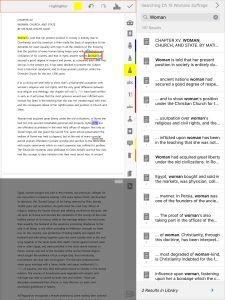
Members of my NarratorsRoadmap.com site can watch my 12-module video course on iAnnotate to learn how to use this software to its fullest advantage in prepping audiobooks.
The post How to highlight text of iAnnotate search results appeared first on Karen Commins.
June 7, 2021
Assembly Tips for Custom-Size Studiobricks Booths
At my previous house, we constructed an additional 16′ x 19′ room in 2005 for my studio. I bought a 6′ x 8′ WhisperRoom which fit well in that space. I happily used it for 15+ years.
After moving to this house in 2018, my WhisperRoom seemed a little too large for the room I chose for the studio. I bought a 6′ x 7′ Studiobricks booth earlier this year. It was delivered in 2 large boxes on 11 May.

Drew and I had watched several assembly videos of standard booths and looked through the instructions from Studiobricks. We thought we were prepared and that the two of us could easily and quickly put the booth together. After all, we’d built the WhisperRoom at each house and disassembled it twice. In fact, Drew almost single-handedly disassembled it this last time for its sale.
Reader, we were not prepared, in large part because Studiobricks (SB) did not send the correct instructions for my booth! This article will outline things we learned through the trial and terror method over several weeks and tips for assembly of custom-size Studiobricks booths.
Before I continue, I do want to say that SB has been extremely responsive to our messages. However, I would have expected that a company that’s been in business for over 10 years would have all their documentation ready and wouldn’t piece-meal it to the customer as they run into problems. If we’d had all the correct guides at the beginning, we could have saved a lot of time and frustration.
1. Get some help to unload the boxes and assemble the booth.My 6′ x 7′ booth weighed 2500+ pounds when delivered in 2 boxes on wood pallets. The boxes were too tall to go in the garage, so they were left on our driveway. We needed to get the pieces in the garage quickly before rain came that afternoon.
Standard-size SB booths have small panels that one person can lift. This custom, double-walled booth has multiple 6-foot pieces that Drew estimates weighed 100-125 pounds. I was of very little help to Drew in unpacking the boxes into our garage. Thank heaven we have a hand truck!
We hired 2 people from College Hunks Hauling Junk to help Drew move everything from the garage to the lower level of the house and then again on another day to help him assemble the booth. I note that the safety instructions on page 2 of the 3rd version of instructions below recommend that 3 people assemble the booth due to its weight.
2. Ask Studiobricks for the most current assembly instructions that match your booth (or use my copies below).They initially sent us the SB Assembling Guide ONE- ONE PLUS -ONE PLUS XXL 2020 (vers. 1). Those booth sizes top out at 4′ x 6′, so most of the blocks pictured did not look like my booth configuration.
On its very first page, the document shows rubber disks that should be attached to the floor panels.
Drew emailed SB because he didn’t see any floor panels that were supposed to hold the Silent Blocks (black rubber disks) as pictured. He asked whether some of the floor panels have disks cut out in places to put the Silent Blocks.
At that point, they sent their SB Assembly Guide CUSTOMIZED Booth (vers. 2), which shows a different approach to building the floor.
Drew installed the booth up to the D level of panels. He wrote to SB with a number of questions. They replied with their SB Assembly Guide Custom Double Wall (vers 3) which is still undergoing English translation but is the most helpful for this booth.
Version 3 does a better job of explaining how to add the vertical and horizontal battens, among other things. We didn’t originally insert the battens as shown on page 9 because they weren’t easy to insert. Once Drew got this third set of instructions, he disassembled the almost-complete booth down to the floor.
However, the battens weren’t the only reason why he needed to start over. A loud floor creak concerned us, and Drew had asked SB about it.
It turns out that we were supposed to add some Silent Blocks under the floor panels where they join per this assembly image that SB sent Drew in response to his question. It would have been very nice if we’d had this picture before he assembled the floor!

For this installation, you will need:
rubber malletthe flat wrench that comes with the booth parts — Mine was included in a ventilator box, so you might have to look around for it.phillips head screwdrivertorx screwdriver T20 (for ventilation kit only)stepladder or twoa hand truck if you don’t have 2 people who can carry the pieces2 window/tile suction cup lifters to help you lift the door if it has a window in ittape measurecarpenter’s spirit/bubble level (not a phone app for leveling)electric drill that can use a 6mm hex wrench/key (Allen wrench) — The booth comes with a little L-shaped one, but an electric one is so much easier to use.wood to prop the door up if you need to adjust the hinges — We used wood from the pallet the booth came on. See the door adjustment and build videos below.4. Test any electrical components before building the booth. Plan your installation so that anything plugged into outlets is accessible after you build the booth or will use extension cables, power strips, and/or surge suppressors.The ventilators shipped with SB booths are designed for 220V electrical systems to go with European systems. They are shipped with power converters to those of us the US.
I got 2 ventilators with this booth and put the converter for each on the floor, outside the booth. The ventilators are mounted inside the booth.
If you’re in the US, you must set the jumper on the back of the converter for 110-volt input. I’ve seen posts from many narrators who thought their ventilator wasn’t working, only to discover that they had missed this important step!
We found that one of my converters didn’t power the ventilator though it was configured correctly. Unfortunately, we hadn’t tested it before plugging it in to an outlet that was behind one of the walls, well out of our reach.
The company immediately sent us another one, but we had a difficult time pulling the cord out of the outlet since the booth walls were up. We decided to run an extension cord for the new converter around the baseboard to a more accessible outlet. We’ll cover that cable with a conduit and still hide the massive converter on the floor out of sight next to the booth wall.
5. Position all the electrical cables so they are near the cable tunnels before you build the walls.When you were designing your booth with Studiobricks, you should have planned your space so that the cable pass-throughs are convenient to the electrical outlets on the wall. Since the booth must draw all electricity from the outside, you’ll need to make sure you can string the cables through the ports after the walls are built.
I need to run cables for my mic, headphones, and light from outside the booth. You can see my cables on the floor next to Drew’s stepladder in the picture above. They terminate next to my desk out of view from this picture. Some people also need the cables powering a computer and/or monitor.
Both of my cable ports face studio walls. As you can see when comparing my booth configuration drawings below with the picture above, the electrical outlet on the wall is almost across from the cable port (adjacent to the 2nd ventilator output), making it easily utilized. The other electrical outlet I planned to use is in the middle of the far wall and not reachable from the corner of the booth.


6. Adjust the door screws so that the door easily closes.
Drew wrote to Studiobricks:
The door does not easily close, which I’m assuming is due to the frame not being exactly square. Will this be fixed with a tight roof frame or will I need to make some adjustments to the components of the door that help keep it closed?
The screw holes on the door for the interior handle don’t exactly line up with the holes on the handle when both handles are installed. There appears to be a misalignment of the larger holes (in the door) for the square rod that connects the interior and exterior handles.
The rod seems to be coming into contact with the edge of the interior hole on the door. This makes it difficult to turn the handle but also doesn’t allow the interior handle to align with the screw holes.
I have the rod inserted into the handles as it describes in the manual so I don’t think it’s something I’m doing wrong.
SB replied with this document to explain how to adjust the door.
We made the explainer video below to help other people understand the process. You don’t want to move the screws very high as the door could start to bind on the top of the frame.
By the way, Drew discovered that 2 of the hinges were screwed in to the door frame using long metal screws. We couldn’t figure out why SB would be clever and make the hinges adjustable and then not use their creation and permanently attach screws to the frame!
The fix requires removing the long screws and replacing them with the smaller ones that allow the hinges to be moved. He found replacement screws at Lowe’s, which look like this:

Drew asked Studiobricks about the door handle. The connecting rod between the inner and outer handles is not allowing the inner handle to match up with the holes drilled for it. Once he resolves this problem with my booth, I’ll update this article with the solution.
This video shows how the booth was delivered and a time lapse of its assembly.
If you’re assembling a Studiobricks booth and would like to have a short (up to 30 minutes), free video chat with Drew, the booth wrangler, send him an email.
The post Assembly Tips for Custom-Size Studiobricks Booths appeared first on Karen Commins.
May 20, 2021
How I Get Stuff Done
Last week, the Audio Publishers Association held its annual conference (APAC), which was skipped last year due to COVID-19 and was virtual this time. They ran it on a site that gave us a virtual meeting space, networking areas, and an exhibit section like an in-person event.
The planning committee had asked me to be one of the experts meeting with small groups of narrators to address their particular questions in the Business Diagnostics session. I had the great pleasure of talking with 6 groups of narrators about time management and marketing/branding topics.
One participant’s question took me by surprise: I narrate. I write. I create content for a membership site. I have a full life beyond work. How do I get so much done?
I say I was surprised because I’ve often wondered the very same thing about other people!
 Initial Answer
Initial AnswerI answered that I still struggle with this issue, sometimes on a daily basis. I always have a lot of things on my to-do list, and I can find it difficult to prioritize them.
“To be clear,” I continued, “other people’s deadlines for audiobook production always get 1st priority.” Rhythms of the household or neighborhood might affect recording time for some people, but I can record whenever I want through the day. I aim to beat all deadlines!
For my own narration projects, I set a general goal for completion and add padding to determine a delivery date to my editor. Why get stressed over self-imposed timeframes?
I don’t set deadlines for my articles, videos, etc. for my sites, with the exception of my bi-monthly newsletter about my projects (sent at 10:00am the 2nd Tuesday of even-numbered months) and the newsletter I send every other Monday at 11am to NarratorsRoadmap.com members about site updates.
I noted that I’m less likely to write or develop other content on a day that I narrate. Narration requires a lot of mental energy!
I maintain a pretty consistent schedule regarding work hours. I usually work 3-5 hours a day, and I definitely don’t like working 8-10 hours a day. If I wanted to perpetually have that level of busyness, I would have stayed with the IRS!
I also plan my daily schedule around the weather forecast. Rainy days are good writing days. In good weather during at least 6 months of the year, I intend to spend my afternoons poolside.
Yogi’s schnauzer alarms must be factored in. I know he expects to take his afternoon walk between 2:00-2:30, so I need to be able to stop what I’m doing by then. Finally, I usually plan at least Sundays as an off-day but often add other days off in the week.
Extended AnswerEven after our time elapsed in the group, the question continued to reverberate in my mind. Like a lot of people, I’m constantly searching for the magic formula that solves the problem of having an overflowing to-do list.
I’ve researched and experimented with methods to divide large blocks of time to produce more finished products, but the small, incremental changes listed below have most increased my output. I suspect that prolific content creators do some of these things to a greater extent than me, such as outsourcing.
1. Help myself first.We all only have so much time each day. I could spend all of my time helping other people and not be able to meet the demand. Plus, people don’t put a high value on advice they receive for free with no effort on their part.
I decided a long time ago that it’s not my job to educate the masses, even in the Facebook groups I’m in. As much as I want to protect the quality of audiobooks, I can only do so much to help people, especially when many refuse the benefit of my knowledge. While I obviously do volunteer a lot of time guiding and advising people, it’s more important that I continue to improve my skills and fulfill my vision for my life.
I stopped doing consultations for this very reason. I found they took too much time from my other pursuits, especially since I spent uncompensated time preparing for them to find links for people and then let the sessions run past the appointed hour to ensure the participant got the info they needed. I freely chose to add value in these ways.
However, a single person caused me to cease consultations. After they dismissed my good advice and suggestions with a negative, somewhat confrontational attitude for the entire hour, I decided the money wasn’t worth going through that experience again.
2. Establish and follow a communications policy.I am most to likely respond to emails if I can do so within 5 minutes. Those messages tend to be ones where I’m able to share a link to something. If my answer would require more time, I want to convert it into some sort of content for my sites. Therefore, I may need weeks to reply at length.
I elaborate on 5 time-saving prongs of my communications practices in this article and encourage you to adopt similar tactics.
3. Repurpose and reuse material.Linking to something relevant that I’ve written (as I so frequently do) only points the way to one form of the idea. Repurposing it, on the other hand, means to repackage it into another format or product. Reusing content this way is the secret sauce designed to get more mileage from it. This Tuesday Tip discusses several examples how to repurpose information. I’ll offer 3 more below.
I copy everything I write in online forums to an Evernote notebook so I can quickly search through my words and repurpose them. For instance, I originally wrote the paragraphs under Item 1 above in a Facebook group for narrators. I harvested them from Evernote and then replanted them into this article.I lifted 3 paragraphs and the keyboard shortcuts from this article and plopped them straight into this Tuesday Tip .The slides I created and information I presented at Johnny Heller’s Splendiferous Workshop last year about creating your own path became the foundation for a video course I made for NarratorsRoadmap.com members.4. Use automated tools whenever possible.Since I’m the Queen of Links, I naturally created a linked list of resources for all the narrators in my APAC Business Diagnostics groups. I then decided to give it away to everyone who visited the APAC NarratorsRoadmap.com exhibitor booth. If you’d like a copy, you can download it here.
With time management as one of my topics, I included relevant Tuesday Tips, a couple of which I’ve already linked to in this article. The 6 tips below from my APAC resources list all relate to automated tools that will speed up your workflow:
7 Use Text Replacement The linked article under #2 above shows a picture of a text replacement. 8 Create Inbox Rules 9 Canned Messages and Templates 17 Memory Aids 19 Schedule Tasks 28 Connect Some Apps 5. Plan your work, and work your plan .The linked article above describes how I employ color-coded calendars and Evernote for monthly and daily to-do lists. An item on my calendar urges me to pay attention to it and do it. A digital calendar is better than a paper planner because it can visually and/or aurally remind me.
I rely on Evernote as my centralized repository for ideas and info. During my Business Diagnostics sessions, 2 people gave me suggestions for future articles they wanted to see. I immediately added them in the appropriate Evernote notebook. You can learn more about my Evernote operations in this post.
6. Outsource work to other people.The Quadrants of Brilliance exercise in this article will help you figure out which tasks you should do and which ones you should delegate to another person or team.
I outsource my editing and proofing of my audiobooks to an editor. My husband Drew not only directs my recording sessions, but he is integral to many other parts of my business. He does both videography and video editing for me, responds to my LinkedIn invitations, adds my audiobook giveaways to promo sites, and manages my mailing list and web site updates. Previously, I was attempting to do all of these things in between other activities. We also hired a fabulous housekeeper who cleans our house twice a month, as well as a lawn service to maintain our yard each week.
7. Focus on a single task at a time.Numerous studies show that our brains aren’t wired to do multiple tasks at the same time. We’re actually less productive when we try to do too many things at once.
A big part of managing multiple projects on a daily basis is scheduling the time for the next task in each one. Knowing that I have the other projects on my calendar gives me the freedom to concentrate on the one at hand.
I’ve found that putting all of my attention on one thing actually makes me feel I have MORE time to finish. Even when talking on the phone to a friend, I’m not doing anything but talking to them. My exception to this rule is if they want me to look at something on the computer that we then discuss together.
8. Limit time spent on social media.I try to adhere to Bonnie Gillespie’s motto about social media: Creator, not Consumer.
I’m constantly invited to join new groups and sites, but I don’t do it. Even though Reddit has audiobook narrator groups, I don’t have an account there and won’t start one. Clubhouse is a hot, new thing, but I refused the invitations to join it.
I set the app limits in my iPhone’s Screen Time module to alert me when I’ve reached the threshold on social media. Even so, I’m constantly exceeding my daily limit.
9. Try different approaches for the same task.My blog articles typically require at least 6 hours to write, in part because I find and test a number of links in each one. Although writing is both a creative outlet for me and a foundation of my business, I haven’t discovered a one-size-fits-all mode of getting it done. I’ve written articles by:
scheduling 30 minutes of content creation daily on my calendar. This consistent practice works pretty well, especially since I don’t just write articles in that time. I create images and promotional pieces, film something for a video, etc. (As an aside, I loved a sea turtle petroglyph I saw in Hawaii and adopted it as my spirit animal when I learned it symbolically meant “self-contained creative source.” Of course, the tortoise is also the symbol for “slow and steady wins the race!”)registering for CJ Hayden’s “Get It Written” days . Paying money to a coach can be a good accountability measure!outlining the article as a draft when the ideas come. Otherwise, I lose them. This option has the benefit of leaving me with lots of material that I can flesh out into a full article.dropping everything and writing the article when the muse is speaking so loudly to me that I can’t think of anything else. Ideas love speed !Every article needs an appropriate graphic to go with it, but searching for a good image can be very time-consuming.
Do you have a favorite time management tip? I’d love to see it, so please leave a comment!
The post How I Get Stuff Done appeared first on Karen Commins.
March 11, 2021
Thoughts About Advice in Narrator Groups
You don’t have to be a student of American history to know about the Donner party.
In the 1840s, this group of around 90 people had heard about the wonders of California and decided to travel west to seek their fortune.
Rather than following the rutted road of the hundreds of settlers before them, they took an unproven shortcut given by a person who had not actually made the trip he proposed and therefore had no business in directing others to go that way. None of the Donner party had traveled the route before, either, so they had no experience or knowledge to measure the shortcut against.
As a direct result of taking the disastrous advice about the shortcut, most of the party didn’t live to tell the tale. Those who did live endured unimaginable and grisly hardships in camp.

While mistakes in audiobook narration don’t carry such severe consequences, they do have repercussions. Therefore, narrators participating in online forums need to be careful about the advice they give and take.
Regardless of the site/group and discussion, established narrators have the same goal — maintain and even improve the quality of the art form.
I can’t express how incredibly frustrating and maddening it is to spend my valuable time offering guidance learned through years of expensive training classes and hands-on practice only to have a newcomer dismiss my hard-won knowledge with the comment “in my experience” and/or an argumentative reply.
I’ve been a member the Facebook Indie (ACX And Others) Audiobook Narrators and Producers for almost 8 years. Recently, I have pulled back a lot from responding in this group because it looks like so many people don’t do any research before dashing off their basic question and only want to be validated in their approach. I repeatedly see questions that are answered in the group FAQ, in the ACX Help Center, and/or on NarratorsRoadmap.com.
I’d much rather help someone who has made some effort, done their research, has a more informed and thoughtful question, and shows a sincere desire to become a great narrator. They say things like:
* I followed your advice, but this is where I got stuck.
* Can you clarify what you meant about this topic?
Instead of gratitude for the assistance received, I see a steady stream of complaints from newcomers about the “snark” from longtime group members and our “vitriolic”, “toxic” comments. People say they are afraid to even ask a question because they don’t want a “mean” answer. Veterans are constantly told we should be more supportive.
No other competitive, artistic field is as supportive as audiobook narrators are to each other! The fact that so many well-established narrators spend our precious spare time trying to help newbies for FREE shows that we want you to succeed.
Why do you insist we reply to you in a way that makes you feel good about yourself? That sense of entitlement stops many veteran narrators from participating.
Why do you expect us to be warm and soothing in our responses, especially when we see bad advice being handed out and adopted?
It’s like “the blind leading the blind”. If an answer seems harsh, it’s because we’re jumping in for the umpteenth time — maybe even today — to save the blind from going in the alley and being beaten up at the end. Sometimes niceties get dropped for a very good reason.
We know what casting people expect. We know what listeners expect. We know you won’t get jobs from publishers or good reviews by implementing the bad habits and practices we’re trying to stop.
No one gave most of us any shortcuts. We paid for classes, read everything we could find, attended conferences which usually involved travel expenses, and took many other actions for years, all to improve as a narrator.
We learned from our own and others’ mistakes and now strive to save newbies from breaking with industry standards and heading into the wilderness. Unfortunately, we might guide 1 person down the safe path of best practices while 20 others run to the “do whatever you want” camp.
It’s not my job to offer info, advice, and encouragement to people on the trail. It’s my CHOICE.
If my advice is not respected and appreciated, I’ll choose to do other things with my time.
Before complaining about the icy tone of a response, just think how it would be if every veteran in the group felt as I do and simply left all the newbies to fend for themselves.
Rather than moving forward in your career as a narrator, you might just find yourself sitting out in the cold.
The post Thoughts About Advice in Narrator Groups appeared first on Karen Commins.



